|
There are more than billions types of insects are
found on Earth. Every day generations of Species being discovered. Some
insects are harmful to humans. Some of them are huge in volume seeing
those scares human. List of all insects is compiled those found here on
Earth. The list of insects includes features and volume about these.
|
|
Giant Weta
New Zealand's giant weta gets its name from the Maori word for "god of
bad looks" -- and it's not hard to see why.
The giant weta could hardly be called pretty but it has a fascinating
history: Scientists believe this species shared its land with dinosaurs,
and had no local predators until European settlers introduced rats to
the island.
Though there are more than 70 weta species on the island, 16 of them are
endangered or threatened, and the country's Department of Conservation
is hard at work trying to save them.
The giant weta is one of the world's heaviest insects: They can grow as
long as three inches and weigh up to 1.5 ounces -- check out the tomato
in the background for a size comparison.
|
|
 |
|
Stag Beetle
The three-inch-long male stag beetle may be most easily recognized by
its spiky front antlers -- also known as mandibles -- which are a key
part of courtship rituals and wrestling matches; you'd have more to fear
from the slightly smaller females, though, which don't have the giant
spikes but do have a more fearsome bite.
The beetles thrive on dead wood, but its numbers appear to be dwindling:
Researchers point to the long maturation time -- 4 years from larvae to
adult -- and "the over-zealous tidying of dead timber and stumps,"
according to ARKive.
|
|

|
|
Goliath Beetle
It's hard to get a real sense of how massive the Goliath beetle is from
this picture, although the smaller bugs around it can help with the
scale.
These beetles are just one member of the 30,000-strong scarab family,
which has roamed the Earth for 300 million years, and reportedly holds
the record for world's heaviest insect: One topped out at 4.5 inches
long and 3.5 ounces.
|
|
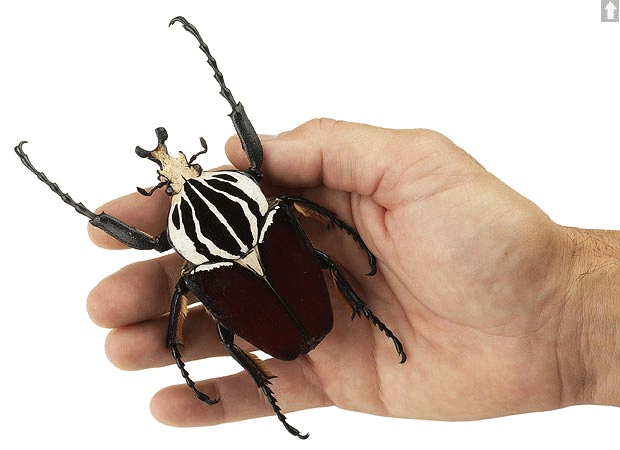
|
|
Giant Walking Stick
Not all giant bugs are outfitted with terrifyingly sharp jaws and a suit
of external armor: The giant walking stick looks practically dainty next
to these plus-sized beetles. Or at least, it would look that way if you
could spot it -- these insects are some of the most successful hiders in
the world, with bodies that very closely match the trees and branches
where they live.
Female walking sticks are often larger than the males, and have been
known to reach as long as 21 inches when measured from toe to toe.
You'll find them almost worldwide, in tropical regions and some
temperate zones, where they take shelter under plants during the day and
feast on leaves at night.
|
|

|
|
Queen Alexandra Birdwing Butterfly
When it comes to insects, butterflies are the kind many find beautiful
on a grand scale -- which is a good thing for the Queen Alexandra
Birdwing, because their wingspan can reach as much as one foot across.
The brightly colored males and more subdued females are found in
rainforests and are native to New Guinea, but habitat destruction has
left them endangered. Their diet -- they thrive on pipeline plant, which
is poisonous to most other creatures -- adds to their allure.
|
|
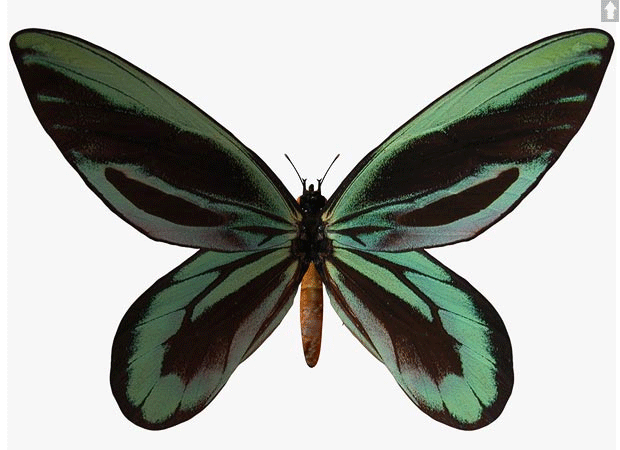
|
|
Titan Beetle
The Latin name of this beetle pretty much says it all: Titanus giganteus.
Not only is it big for a beetle -- it's the most massive member of its
species, longhorn beetles, and the longest beetle found so far in the
Amazon rainforest -- it's just plain huge, with adults reaching as long
as 8 inches in length. That's longer than some Chihuahuas, the Natural
History Museum points out, to put this length in perspective.
Wikipedia claims that the larvae of the titan beetle have never been
seen in person, but that "boreholes thought to be created by titan
beetle larvae seem to fit a grub over two inches wide and perhaps as
much as one foot long."
|
|
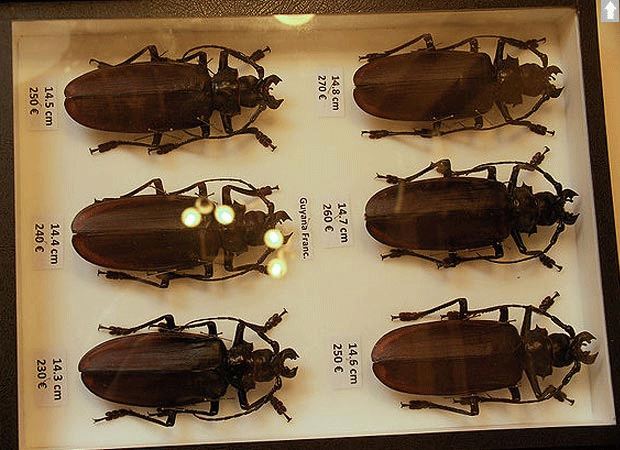 |
|
Dung Beetle
Though the dung beetle doesn't have the size advantage of some of the
other beetles and bugs on this list, it overpowers them in one key
weigh: It's gifted with Hulk-type strength.
While larger animals can carry more weight overall, they can't carry as
much proportional weight; the dung beetle can move items with a mass
that's 1,141 times heavier than itself. (To borrow an example, this
would the equivalent of a human pulling 180,000 pounds, or "six full
double-decker buses").
But why are they so strong? Researchers explained that males need to be
tough enough to fight off rivals who would try to pull them out of the
holes they go into in order to mate with females.
|
|
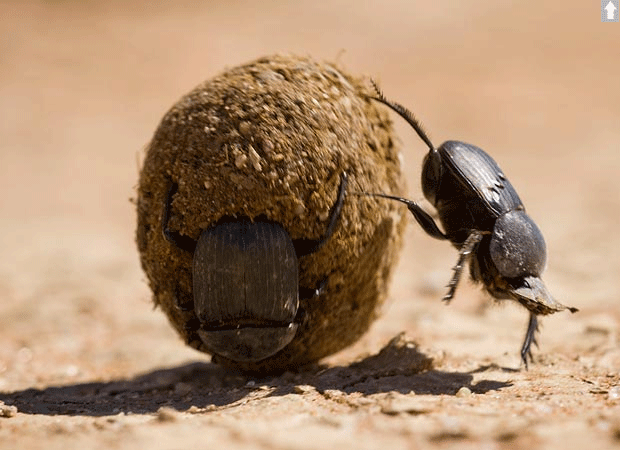 |
|
Giant Water Bug
It's not unusual for water bugs to be mistaken for cockroaches -- but at
four inches long, the giant water bugs are noticeably bigger. These bugs
thrive near slow-moving water where they can eat tadpoles and small fish
(and survive on crickets when in captivity).
The small, round sacs on the back of this male water bug are eggs; the
female water bug lays them on his back, secreting a gluey liquid to
attach them, and the male carries them until they hatch.
|
|
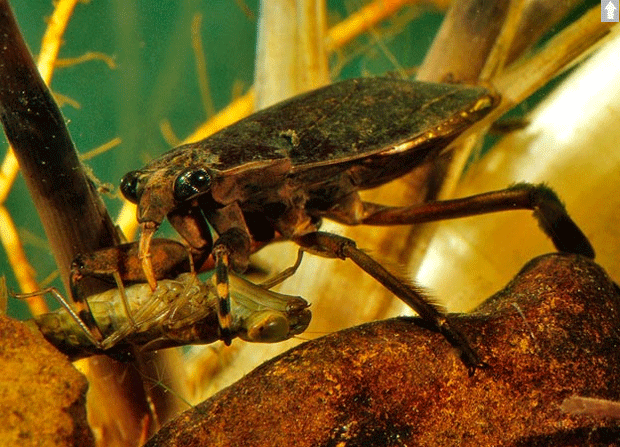 |
Atlas Moth
The Atlas moth, so called for either the mythological Greek giant of the
same name or the wing patterns that look like maps, has the biggest wing
surface of the moth family (many have more than 62 square inches of
wing, though they don't have the widest wingspan).
The Atlas lives primarily in Southeast Asia, where residents rely on its
silk. Instead of spinning one endless strand, the moth's silk comes out
in broken pieces, but it's also considered a sturdier substance.
|
|
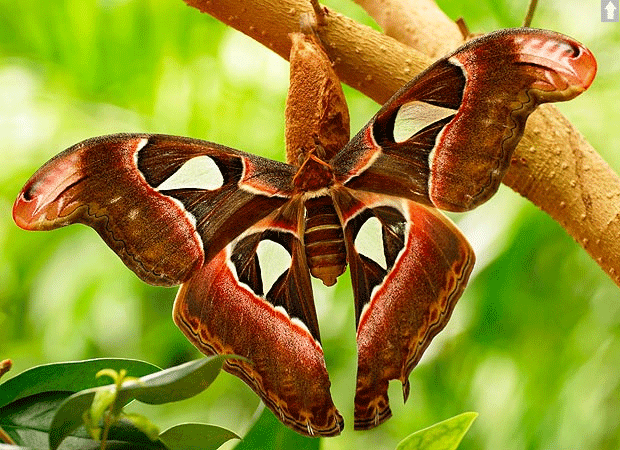 |
|
Goliath Bird-Eating Spider
We'll expand the category of "bug" to include this massive arachnid, the
Goliath bird-eating spider, which -- though it's the size of a dinner
plate -- is relatively harmless to humans.
But it's not so harmless if you're a frog, lizard, small snake, or --
yes -- baby bird: The toothless spider incapacitates its victim by using
the venom in its fangs, and then spits digestive juices onto the prey so
that it can "slurp up its meal," says Extreme Science. "All that's left
when the spider has finished its meal is bones, skin, fur, and/or
feathers."
|
|
 |